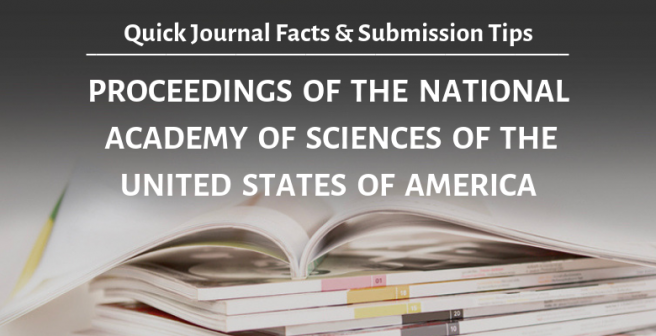PNAS: Quick facts and submission tips

Aims and scope | PNAS (Proceedings of the National Academy of Sciences) publishes more than 3000 research papers annually in all branches of science – physical, social, and biological – and requires that all papers be "intelligible to a broad scientific audience." |
Publisher | National Academy of Sciences, USA |
Frequency of publication | Weekly (52 issues a year, which make up one volume) |
Editorial information | The Editor-in-Chief is Inder Verma, who is American Cancer Society Professor of Molecular Biology in the Laboratory of Genetics at the Salk Institute for Biological Studies in La Jolla, California. His primary area of research is cancer genetics and gene therapy. PNAS also has ten associate editors and a large editorial board representing thirty-one branches of science from anthropology to sustainable science. Further details are available here: www.pnas.org/site/misc/masthead.xhtml. |
CRITERIA FOR PUBLICATION
PNAS publishes ‘cutting-edge research’ and papers ‘must be of exceptional scientific importance.’ Contributions to PNAS are published under any of the following categories: Research reports, Letters, Front matter, Commentaries, Perspectives, and Colloquium papers; all but the first two are written only at the invitation of the editorial board.
EDITORIAL POLICIES AND SUBMISSION GUIDELINES
Contributions must be submitted online through the PNAS Manuscript Submission System at www.pnascentral.org/cgi-bin/main.plex. New authors are required to register first. Detailed information on the preparation of manuscripts is available at www.pnas.org/site/authors/procedures.xhtml.
MANUSCRIPT REVIEW PROCESS
Each paper is assigned to a member of the PNAS Editorial Board from one of the 31 branches or disciplines defined by the journal. If a contribution passes this initial review, it is then taken over by one of the Member Editors, who may enlist specialist reviewers and evaluates their recommendations. The final decision is taken by the member of the editorial board. An infographic showing the process in detail is available at www.pnas.org/site/misc/reviewprocess.pdf.
GOOD PUBLISHING PRACTICES
PNAS offers quick turn-around times: the initial decision is taken in about 40 days; the average time between acceptance and publication online is one month; and the average time between submission and publication (including the print edition) is less than 6 months. PNAS papers can be freely accessed 6 months after publication, and many other types of content are freely available much earlier than that. A comprehensive section of FAQs (frequently asked questions) by authors is here: http://www.pnas.org/page/authors/author-faq.
INDEXING & METRICS
The impact factor for 2014 is 9.423.
USEFUL LINKS
Journal homepage: www.pnas.org
Instructions to authors: www.pnas.org/site/authors/index.xhtml
Editorial board: http://www.pnas.org/page/about/editorial-board
Infographic showing the review process: pnas.org/site/misc/reviewprocess.pdf
Detailed information on the preparation of manuscripts: www.pnas.org/site/authors/procedures.xhtml
Published on: Sep 27, 2016
Comments
You're looking to give wings to your academic career and publication journey. We like that!
Why don't we give you complete access! Create a free account and get unlimited access to all resources & a vibrant researcher community.

Subscribe to Journal Selection










